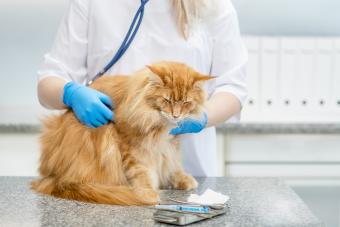
How often do you take your cat to the vet? Your pet's age may dictate frequency of vet visits. With that in mind, felines are stoic and often hide when they're feeling pain. Don't wait until an annual visit if your cat behaves a little off for a few days. All cats need to see the vet at least once a year for wellness exams, vaccinations, and diagnostics.
How Often Do You Take a Cat to the Vet?
Annual wellness visits are about much more than a few vaccinations. Your indoor and outdoor cats should see a vet! It's important for pet parents to keep a journal throughout the year with notes about how often their kitty eats, drinks, and makes trips to the litter box. During a wellness visit, cat owners need to talk to their vet about any behavioral changes over the previous six months. All adult cats need a regular health exam at least once a year. Healthy and bright adult cats benefit from annual diagnostics. As your cat ages, semiannual examinations are necessary to discuss medical conditions like arthritis.
Kittens
Kittens visit the vet until a full set of vaccinations is complete. After the initial appointments, your vet provides a treatment plan for an annual exam.
Adults
An adult cat is between one and 10 years of age and needs an annual examination. The wellness exam includes lab work, a nail trim, vaccinations in some cases, and an oral exam.
Seniors
Cats that are 10 and older are senior felines who need semiannual examinations. Seniors may need more comprehensive lab work to rule out any medical conditions.
Schedule Diagnostics
Typically during the wellness exam, the vet wants to run routine lab work to ensure your cat is healthy and free of parasites. In many cases, vets may detect the first signs of disease in blood or urine. The lab work may need to occur during a separate appointment if your cat is extremely anxious during the initial wellness exam.
Minimize Vet Visit Stress
Always train your cat to ride in his carrier weeks before the actual physical exam. Start with a few practice runs each week so your cat is used to riding in the car. You want to avoid a stressful car ride. The vet assesses the cat from head to toe and wants to make the experience positive for your feline. Set your cat up for success.
Choose the Right Vet
There are many reasons for your cat to see both a general practitioner and a holistic or integrative vet. Both of these types of vets may need to be on your cat's medical team. A regular vet helps with wellness exams and performs bloodwork. Holistic vets provide advice for herbs and alternative treatments your cat may benefit from during their lifetime.
Appropriate Wellness Exam Procedures
Whether you live with a cat or kitten, it is essential to talk to your vet about the procedures your cat needs throughout the year. There are essential or core treatment plans and age plays a big part in the discussion. Cat owners need to talk to their vet about their kitty's indoor and outdoor environment as a parasite prevention medication is important to keep a cat healthy.
- Microchipping is common in most vet clinics and helps pet owners find lost cats.
- Parasite preventive medication is important for indoor and outdoor cats.
- Spay and neuter procedures are considered surgery, and your vet can help determine when this is needed.
Annual Wellness Exams Are Essential
Vaccinations are only a small part of the annual exam. The age of your cat may dictate a semiannual exam schedule for the year. Cats are stoic and hide their pain well, so it is crucial pet parents closely observe their felines throughout the year. Between wellness appointments, if there are any concerns, cat lovers need to schedule an exam with their vet.







